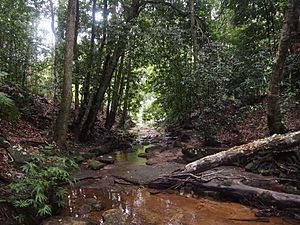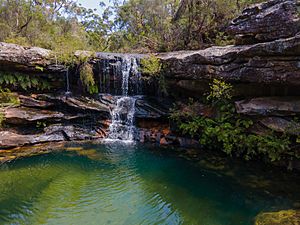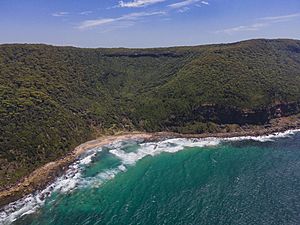Royal National Park facts for kids
Quick facts for kids Royal National ParkNew South Wales |
|
|---|---|
|
IUCN Category II (National Park)
|
|

A view of the Era beaches on the Royal National Park Coast Track, looking south from Thelma Head
|
|
| Nearest town or city | Sydney |
| Established | 26 April 1879 |
| Area | 150.91 km2 (58.3 sq mi) |
| Managing authorities | NSW National Parks & Wildlife Service |
| Website | Royal National Park |
| See also | Protected areas of New South Wales |
The Royal National Park is a special protected area in New South Wales, Australia. It's located south of Sydney in the Sutherland Shire area.
This huge park, about 151 square kilometers, is only about 29 kilometers south of the center of Sydney. It's close to towns like Loftus, Otford, and Waterfall.
It was officially opened on April 26, 1879, by Sir John Robertson. This makes it the very first national park in Australia! It was created only seven years after Yellowstone National Park in the United States. At first, it was just called "National Park." But in 1955, it was renamed "Royal National Park" after Elizabeth II, the Queen of Australia, passed by on a train during her visit in 1954.
In December 2006, the park was added to the Australian National Heritage List. This means it's a very important place for Australia's history and nature.
What You Can See and Do
The Royal National Park is on the traditional lands of the Dharawal people, who are Aboriginal Australians.
Inside the park, you'll find small towns like Audley, Maianbar, and Bundeena. There used to be a train line here, but now it's a heritage tramway run by the Sydney Tramway Museum in Loftus.
You can get to Audley by road from Loftus, Waterfall, or Otford. There are also train stations nearby, including Loftus, Engadine, Heathcote, Waterfall, Helensburgh, and Otford. You can reach Bundeena and Maianbar by road through the park or by a ferry from Cronulla.
The park has many fun things to do! You can find lots of places for cycling and walking, as well as barbecue and picnic spots. There are over 100 kilometers of walking tracks that show off different kinds of scenery. You can ride bikes on some fire trails and special mountain biking tracks. Just be careful, as these tracks go both ways! If you bring a car into the park, there's a $12 fee.
Popular Walks and Activities
The most popular walk is the Coast Walk. It goes along the park's eastern edge and offers amazing views of the ocean. This track is 30 kilometers long, stretching from Bundeena to Otford. Most people take two days to complete it. This walk is often part of The Duke of Edinburgh's Award program.
The Wallumarra Track, built in 1975, is used for environmental education. "Wallumarra" is an Aboriginal word meaning education or protect. Many schools, colleges, and other groups use the park to learn about nature.
Bushfires and Safety
The park has had bushfires many times, like in 1939, 1994, and 2001. But Australian native plants are amazing! They naturally grow back after fires, so you won't see many signs of them today. If there's a very high fire danger, the park might close to keep everyone safe.
Camping in the Park
You can camp at Bonnie Vale, North Era, and Uloola Falls. These are the only places where camping is allowed. You need to book your spot ahead of time. While there's a fee for cars, it's free for people who walk into the park.
Nature and Wildlife
Royal National Park has many different types of landscapes. You'll find tall coastal cliffs with beaches and small coves. There's also an old, high plateau with deep river valleys. These rivers flow north into Port Hacking, a large but shallow harbor that forms the park's northern border.
The park's rocks are mostly Triassic Hawkesbury Sandstone. Some parts have Wianamatta shale on top. Deep below, there are coal seams, which are layers of coal.
Coastal Heathland
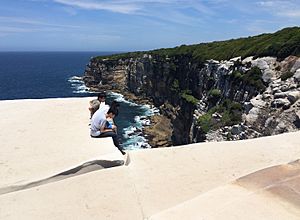
Along the entire coast of the park, you'll find coastal heathland. This area has tough, low-growing shrubs that can handle salt and rocky ground. The coast itself has high cliffs, some almost 100 meters tall at the southern end.
These cliffs have beautiful sandy beaches that are great for swimming and surfing. Some beaches can be reached by road, while others require a long walk. These heathlands are home to many small birds, like the New Holland honeyeater.
Common plants here include Coastal rosemary, she-oak, and grass trees. You might also see sundew and different types of banksia.
Birds like Lewin's honeyeater, beautiful firetail, and southern emu-wren live in these heathlands.
Littoral Rainforest
The park also has littoral rainforest, which is a special type of forest found near the coast. This kind of forest is often destroyed when coastal areas are developed, but it has survived here. One example is the "Palm Jungle" along the Coast Walk. It has trees like tuckeroo and coastal tea tree.
Uplands and Valleys
As you go further inland, the land rises to rocky ridges and plateaus. These areas have tough, low-growing shrubs and poor soil. These ridges are what's left of a much larger plateau that has been worn away by rivers. This ridge habitat is very important because many similar areas have been built on, making some species endangered.
Valley Sides: Sclerophyll Forests
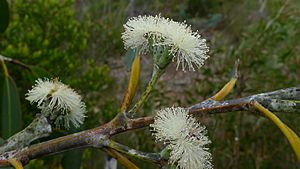
On the sides of the steep river valleys, you'll find more exposed rocks and pockets of soil. Many eucalyptus and other tree species grow here. Small streams are common, and smaller plants grow under the larger trees. This area is typical of coastal New South Wales and has a wide variety of plants.
This environment is called sclerophyll open forest. It can be "dry" or "wet." Factors like bushfires, low nutrients, hot summers, and low water levels shape this habitat. This leads to a diverse mix of plants and animals. For example, some eucalyptus trees have smooth bark to reduce fire risk, while others have bark that burns easily, helping their seeds grow after a fire.
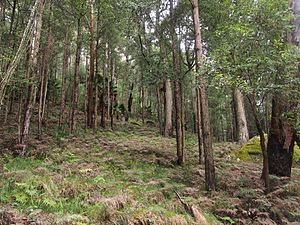
You'll often see trees like Sydney redgums, Sydney peppermints, and red bloodwoods. Many beautiful flowers also grow here, such as the Sydney waratah, flannel flowers, and various orchids.
Many birds live in this habitat, including Golden whistlers, yellow-tailed black cockatoos, laughing kookaburras, and eastern whipbirds.
You might also spot native animals like wallaroos and common echidnas. If you're lucky, you might even see a koala, a dingo, or a spotted quoll.
Valley Floors: Rainforests and Big Trees
The valley floors have rich soil and plenty of water, making them cooler and more humid. Large trees like Australian cedar and big eucalypts grow here, reaching 50 meters or more! There's also a thick undergrowth of ferns and wattles.
Some small areas are temperate rainforest. These have dense groups of very large trees, including the famous Port Jackson fig and Moreton Bay fig trees. Because there's not much light on the ground, you'll mostly see ferns. These areas are popular with visitors and are carefully protected because they are rare in Australia's hot, dry landscape.

You can also see impressive groups of turpentine and blackbutt trees. They grow straight up, forming an open canopy. In these areas, you might find grassy ground or a thick understory of rainforest plants. Rainforest pockets have trees like jackwood and sassafras. The lilli pilli produces fruit you can eat!
Birds that live in these rich rainforests include Topknot pigeons, green catbirds, and rufous fantails. Two interesting birds you might see are the flightless brush turkey and the amazing superb lyrebird, which can copy many sounds.
Platypus Reintroduction
Platypus used to live in the Hacking River. In May 2023, these unique animals were brought back to the park! This was part of a special program by the University of New South Wales, NSW National Parks and Wildlife Service, and the World Wildlife Fund. The platypus have tiny transmitters, so scientists can watch them in their new home.
Riparian Forest: Life by the Water
Close to running water, usually within 10-25 meters, you'll find a special group of plants. This "riparian zone" often has rare or threatened species. Common plants here include Blackbutt, Sydney red gum, and bottlebrush. You'll also see tree ferns.
Many different animals live in this zone, including molluscs, crustaceans, insects, fish, and birds. Long-finned eels, which travel from the ocean as babies, grow up in the park's creeks and streams. You can often see them in the murky water of pools along the Hacking River.
Mangroves and Salt Marsh: Coastal Nurseries
Along the shoreline of the park, especially near the Port Hacking Estuary, there are mudflats with mangrove woodlands. The main trees here are the grey mangrove and the river mangrove.
These mangroves are very important! They act as nurseries for almost all major fishing fish, like yellowfin bream and luderick. Young fish hide and grow here before moving to open waters. Mangroves also provide food for many crabs and molluscs. You might see soldier crabs, semaphore crabs, and hermit crabs.
Dozens of different bird species feed in the mudflats around the mangroves. Many of these birds are endangered and protected by international agreements. You might see Eastern curlews, striated herons, little egrets, and Australasian pelicans.
Tidal Rockshelves and Rock Pools
The coastline and the Port Hacking Estuary have many sandstone rockshelves and rock pools. These are broken up by small sandy beaches and freshwater inlets.
You'll find many molluscs here, like black nerites and turban snails. The Sydney rock oyster, which is farmed for food, also lives here. A common seaweed in the rock pools is Neptunes necklace, which looks like a string of beads. You might also see beds of cunjevoi, a type of sea-squirt. The waratah anemone, named after the flame-red waratah flower, is a beautiful sea anemone found here. The biscuit sea star is a common sea-star in the rock pools.
Important Safety Note: The blue-lined octopus, which is very poisonous, can be found in small or large rock pools. It's almost impossible to see unless someone points it out. If you touch it, its venom can be deadly in minutes. The best way to stay safe is to never put any part of your body into a rock pool.
Park Highlights

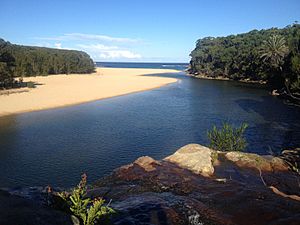
- Audley – This is a large, flat area at the bottom of one of the park's biggest valleys. The main road from the north drops down to Audley, where it crosses the Hacking River. In the late 1800s, Audley was a popular picnic spot for people from Sydney. You can still see a old timber boathouse where you can rent rowing boats and canoes to explore the river. There's also a dance hall, picnic areas, grassy fields, a café, and restrooms. Audley is still a favorite spot for families today. After heavy rain, the river can flood, closing the road.
- Jibbon Point – This is the southern tip of Port Hacking, with great views of the Sutherland peninsula. You can see Aboriginal rock art sites here, which were used for special ceremonies. The name Jibbon comes from the Dharawal word for Port Hacking, "Djeebun."
- Eagle Rock – This is a unique rock formation near Curracarong, about halfway along the coast. It looks like an eagle's head when you see it from the side. Near here, several waterfalls tumble over the cliffs and into the sea, over one hundred meters below!
- Garie Beach – One of the most popular surf beaches in the park.
- Wattamolla Beach – This spot has a large lagoon behind the beach, which flows into the sea. Families love playing in the calm lagoon with young children, while adults enjoy the clean surf. There's plenty of parking, but it can get full on busy summer weekends. Wattamolla is a sheltered cove with a sandy bar. A beautiful waterfall from Coote Creek rushes over a sandstone cliff into the lagoon.
- Figure 8 Pools – These are unique rock pools south of Burning Palms beach.
- Lady Carrington Drive – This was one of the first roads through the park. It runs south from Audley, following the Hacking River for about 10 kilometers. It used to be a popular carriage drive. Now, it's one of the most popular walking and cycling tracks. It's mostly flat and wide. In spring, you'll see bright yellow wattle trees and orange and red banksia flowers. Many schools use Lady Carrington Drive for sports or fundraising events, with students walking from the southern end to Audley for a big barbecue picnic.
- North and South Era Beaches – You can camp at North Era campground, which overlooks North Era beach. These campsites are perfect for an overnight stop if you're walking the Coast Track. Burning Palms Beach is a common rest spot for hikers on the coastal walk. It's known for its unique palms and the nearby 'Figure 8' rock pools.
- Winnifred Falls and South West Arm Pool – These are natural freshwater and saltwater swimming holes at the base of Winnifred Falls on South West Arm Creek.
- Royal Coastal Walk – This is the most popular track in the park, stretching from Bundeena to Burning Palms and up to the Otford Cliffs.
Heritage Listings
Royal National Park has some places that are listed as important heritage sites, including:
See Also
 In Spanish: Parque nacional Real para niños
In Spanish: Parque nacional Real para niños
|


